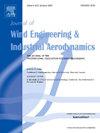Performance assessment of deep learning models for reconstructing missing pressure data on the high-speed train from wind tunnel tests
IF 4.9
2区 工程技术
Q1 ENGINEERING, CIVIL
Journal of Wind Engineering and Industrial Aerodynamics
Pub Date : 2025-07-25
DOI:10.1016/j.jweia.2025.106185
引用次数: 0
Abstract
Missing pressure data frequently occurs in surface pressure distribution tests. Traditional methods, including mean, median, or regression imputation, rely on statistical measures or relationships to fill missing values. Comparatively, deep learning offers innovative approaches through autoencoders or generative adversarial networks, which can learn dataset patterns and generate plausible data, thereby enhancing completeness. Relying on pressure measurements from wind tunnel experiments, with inflow speeds varying between 2 and 18 m/s, this paper analyzes the train surface pressure distribution and explores deep learning-based reconstruction for missing data. Results show that as wind speeds increase, absolute pressure values rise proportionally, while distribution patterns remain consistent with prior findings. Moreover, deep learning models exhibit notable reconstruction performance, albeit with differing accuracies. Specifically, the Kolmogorov-Arnold Network achieves the highest precision, recording a 3.26 % average error, followed by the Multilayer Perceptron (7.08 %) and the Long Short-Term Memory network (8.90 %). Such discrepancies underscore the unique capabilities and limitations of each model. These findings demonstrate the efficacy of deep learning techniques in recovering missing pressure data and highlight their potential to augment wind tunnel datasets, ultimately offering a valuable reference for future investigations seeking to address data gaps in aerodynamic research and strengthen data-driven analyses and engineering practice.
风洞试验中高速列车缺失压力数据重建的深度学习模型性能评估
在地面压力分布试验中,经常出现压力数据缺失的情况。传统的方法,包括平均值、中位数或回归归算,依赖于统计测量或关系来填补缺失值。相比之下,深度学习通过自动编码器或生成对抗网络提供了创新的方法,可以学习数据集模式并生成可信的数据,从而提高完整性。本文以风洞实验的压力测量为基础,在进流速度在2 ~ 18 m/s之间变化的情况下,分析了列车表面压力分布,并探索了基于深度学习的缺失数据重建方法。结果表明,随着风速的增加,绝对压力值呈比例上升,但其分布规律与前人的研究结果保持一致。此外,深度学习模型表现出显著的重建性能,尽管精度不同。具体来说,Kolmogorov-Arnold网络达到了最高的精度,记录了3.26%的平均误差,其次是多层感知机(7.08%)和长短期记忆网络(8.90%)。这种差异强调了每种模型的独特能力和局限性。这些发现证明了深度学习技术在恢复丢失的压力数据方面的有效性,并强调了它们在增加风洞数据集方面的潜力,最终为寻求解决空气动力学研究中的数据缺口、加强数据驱动分析和工程实践的未来研究提供了有价值的参考。
本文章由计算机程序翻译,如有差异,请以英文原文为准。
求助全文
约1分钟内获得全文
求助全文
来源期刊
CiteScore
8.90
自引率
22.90%
发文量
306
审稿时长
4.4 months
期刊介绍:
The objective of the journal is to provide a means for the publication and interchange of information, on an international basis, on all those aspects of wind engineering that are included in the activities of the International Association for Wind Engineering http://www.iawe.org/. These are: social and economic impact of wind effects; wind characteristics and structure, local wind environments, wind loads and structural response, diffusion, pollutant dispersion and matter transport, wind effects on building heat loss and ventilation, wind effects on transport systems, aerodynamic aspects of wind energy generation, and codification of wind effects.
Papers on these subjects describing full-scale measurements, wind-tunnel simulation studies, computational or theoretical methods are published, as well as papers dealing with the development of techniques and apparatus for wind engineering experiments.

 求助内容:
求助内容: 应助结果提醒方式:
应助结果提醒方式:


